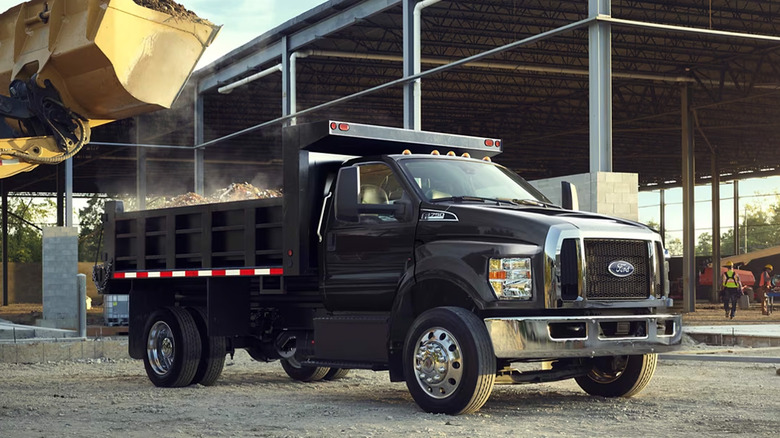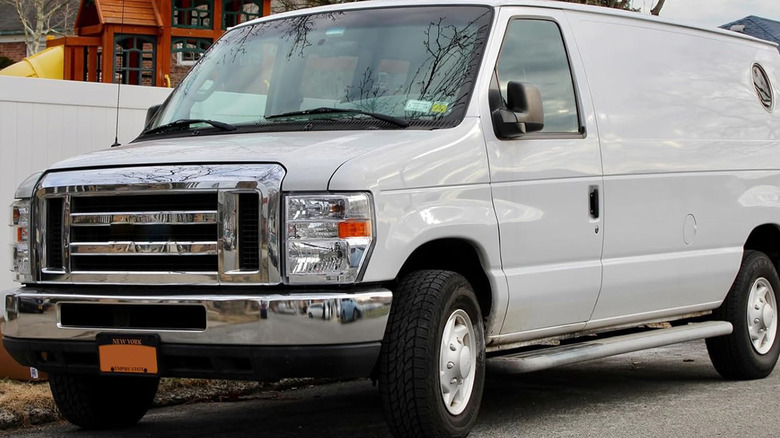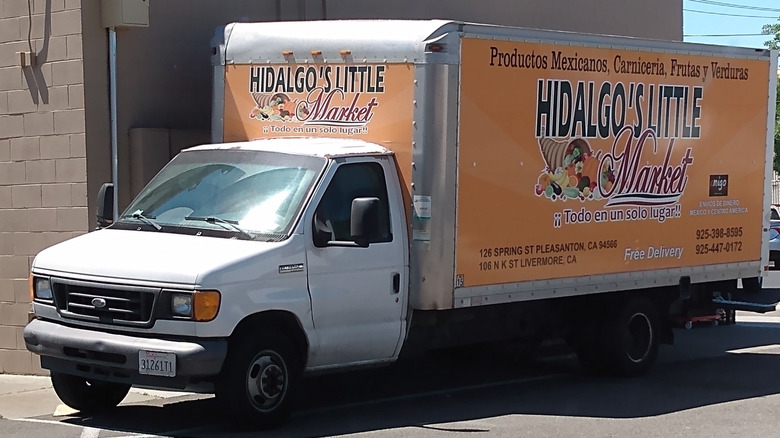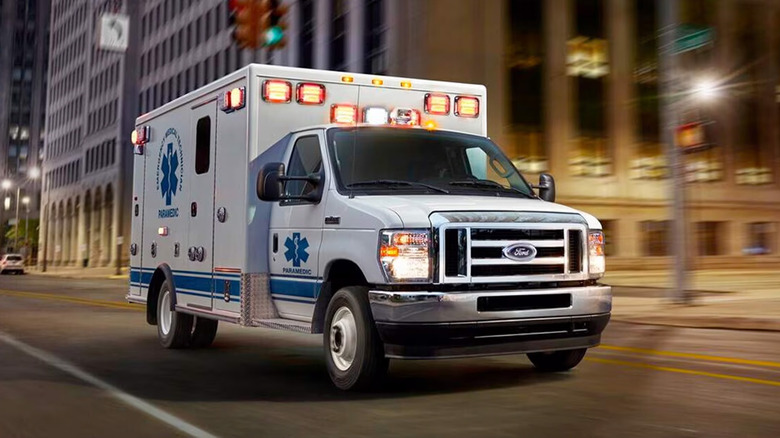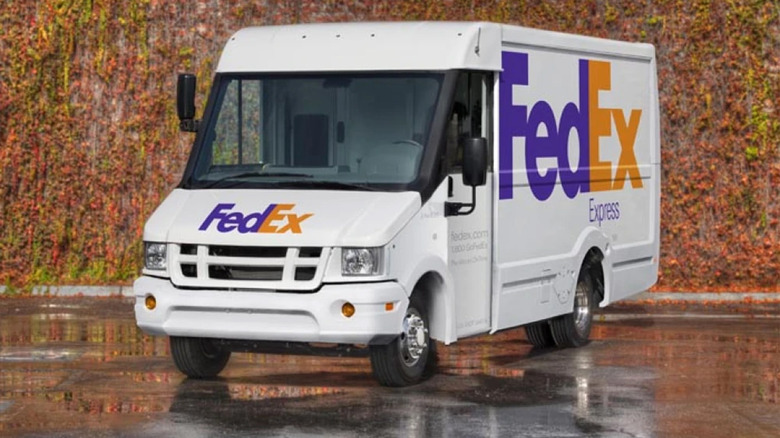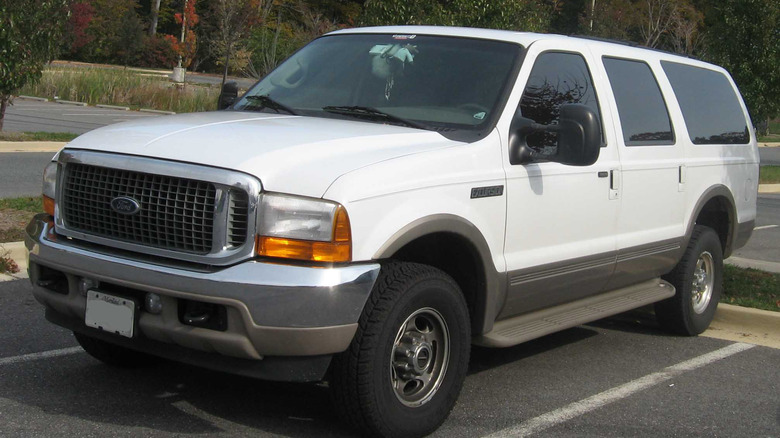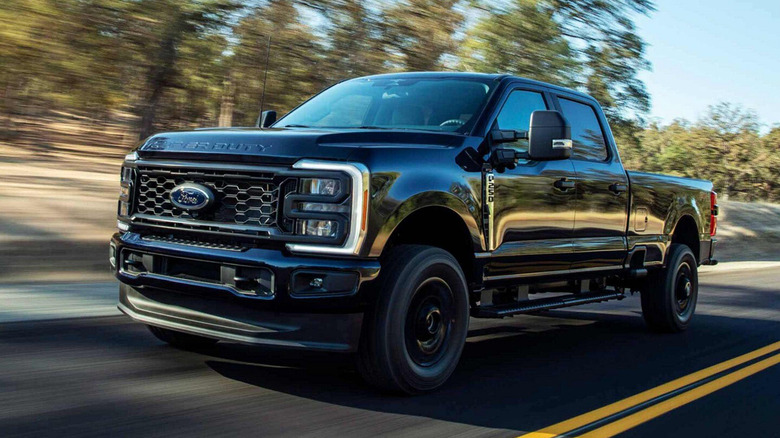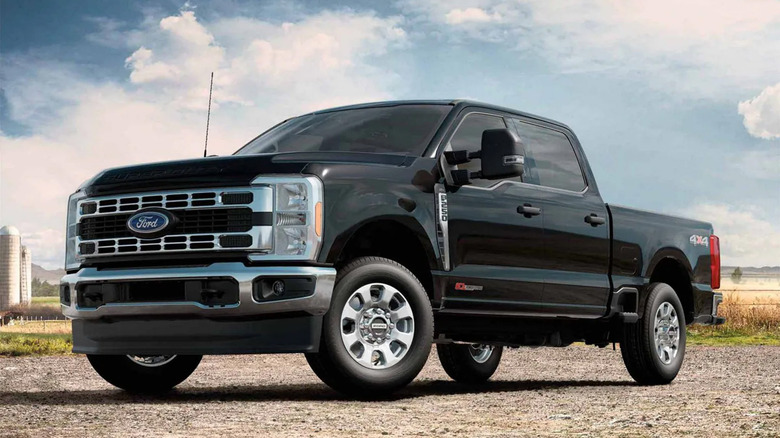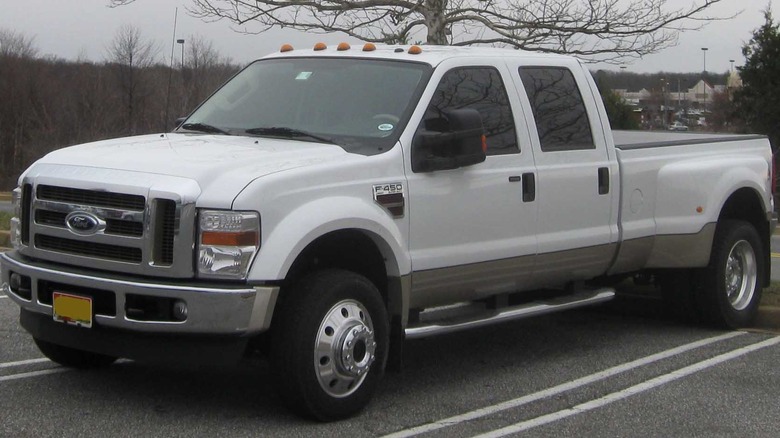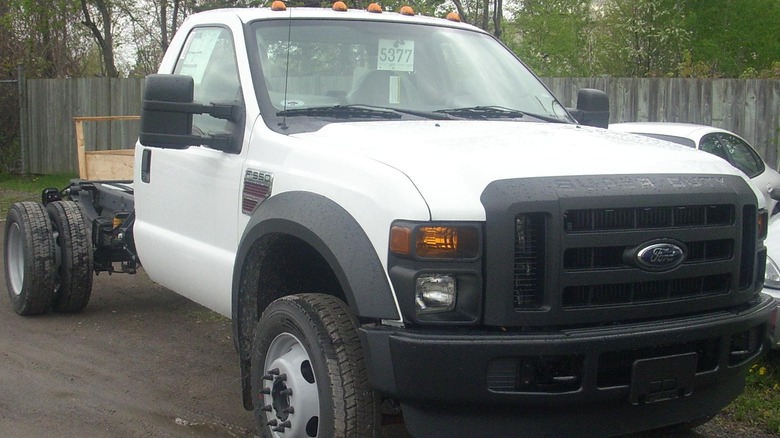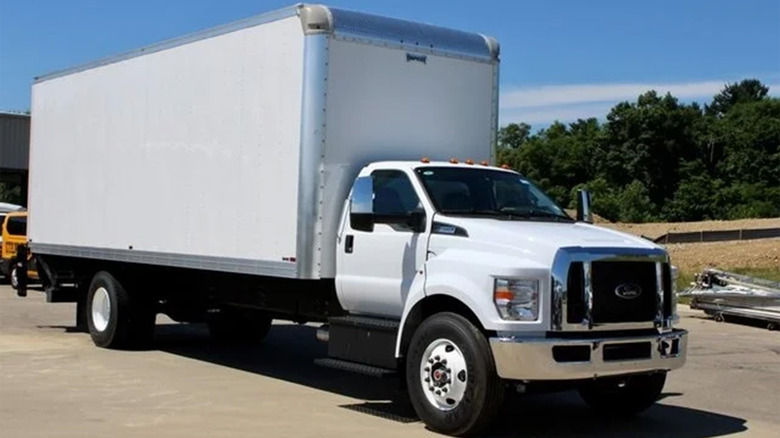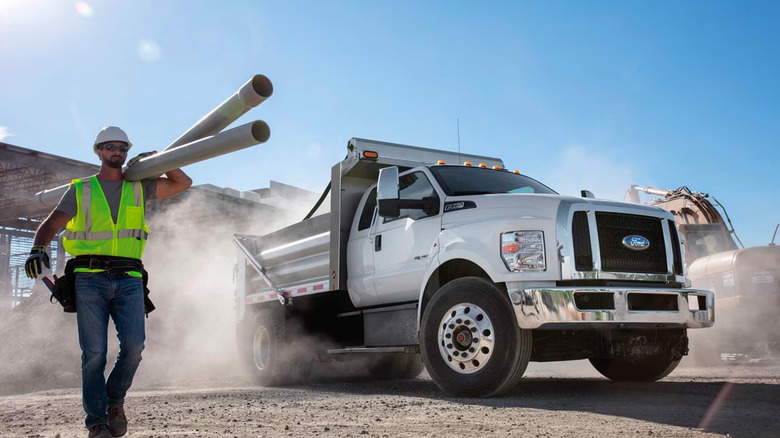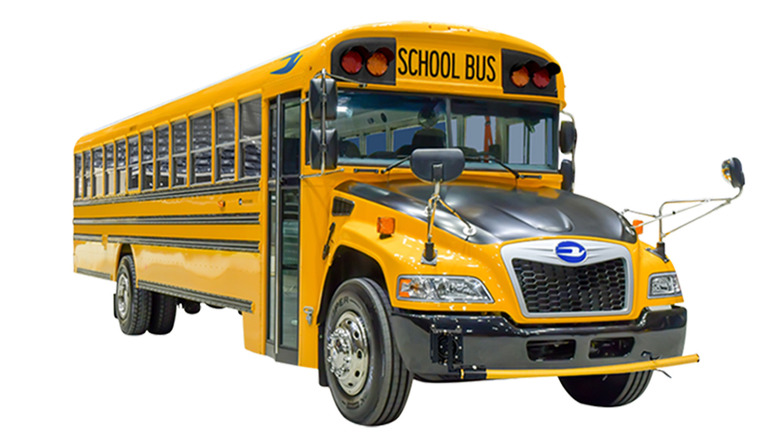Every Ford Model Powered By The 6.8L V10 Engine
We may receive a commission on purchases made from links.
Whether it's the 428 Cobra Jet that powered some of the brand's most iconic sports cars or the legendary 427 V8 that helped Ford win Le Mans in the 1960s, Ford is always part of the conversation when it comes to great engine design and power. It's even built impressive engines for other brands such as Koenigsegg and Lotus, both of which have used Ford V8 engines in the past. In general, people tend to remember the engines that make cars go fast.
However, Ford is also adept at making engines that last a long time with plenty of power for work as well. One such example is the Ford 6.8-liter V10 Triton engine. It may not jump out at many folks as one of Ford's most iconic engines but the plucky V10 has been powering vehicles you see almost every day for much of the last 25 years. Ford initially built the engine in 1997 and retired the motor in 2021. Over its 25-year lifespan, the engine went from 275 hp and 425 lb-ft of torque to a maximum of 360 hp and 457 lb-ft of torque. Despite its beefy nature, Ford never put this engine in a supercar, although it came close a couple of times.
So where did Ford use the 6.8-liter V10 Triton? In work trucks, cargo vans, and plenty of other commercial-oriented applications. You've seen these vehicles everywhere as they range from dump trucks to FedEx trucks, and some other stuff as well. Here's every vehicle powered by the 6.8-liter V10 Triton.
Ford E250
Let's start with the humble Ford E250 van. Ford has been making this van since 1961 and still makes it to this day. You rarely see consumers driving this one around, but it's a favorite of tradespeople and businesses who need a cargo van. It's also found a home in the secondary market as a common option for people who want to live out of their van Chris Farley style. Such a van would obviously need some power to carry all the tools and materials people need for work.
In general, most E250 vans made during the Triton V10's era carried a slew of different V8s from Ford. The V10 was an option on the van, but it seems to have been fairly rare. From what we could find, Ford used the engine as an option in the E250 in the mid-to-late 2000s and early-to-mid 2010s. Some people have also bought used E250s with the standard V8 engine and swapped a V10 into it. In general, the V10 was likely a little much for the E250 since the engine was built for larger vehicles.
As such, the V10 E250 is a tad rare, and the overwhelming majority of E250 listings we found sported a V8 engine. You might have an easier time getting one through an engine swap.
Ford E350
While the E250 with a V10 is a rarity, the E350 with the Triton V10 is a lot more common. One of the earliest examples of the V10 in a Ford vehicle, the first E350 came with the engine in 1997, the same year the engine came out. Ford continued stuffing the E350 with the V10 until 2019. Ford skipped the 2020 model year and the 2021 E350 featured two 7.3-liter V8 engines. At 22 years, the E350 had the Triton longer than most vehicles in Ford's lineup.
In general, the E350 comes in two configurations, the standard cargo van and the cutaway model that customers can use to mount whatever they want. Consumers tended to use the cutaway as the chassis for a box truck or as a shuttle bus. Most people likely know the E350 as the standard-size U-Haul moving truck, which uses the E350 chassis. Since most uses of the E350 are as shuttle buses or cargo trucks of some sort, it's highly likely you've passed dozens, if not hundreds of these things on the road without realizing it.
Since the V10 lasted for so long in the E350, there are many more examples of E350s with the V10 engine. Most of them seem to be box trucks, so likely not something you'd buy as a consumer.
[Featured image by DestinationFearFan via Wikimedia Commons | Cropped and scaled | CC BY-SA 4.0]
Ford E450
The Ford E450 continues the tradition of the E350 in that you've probably seen hundreds of these on the road without realizing it. The E450 is used for ambulances, motorhomes, and larger U-Haul trucks. Ford also sells these to businesses for use as standard box trucks, shuttle buses, and even as campers. Similar to the E250 and E350, Ford primarily sells the E450 to businesses. Unlike the E350, the E450 is only available with a cutaway design so that something can be mounted onto the back.
The E450 also had the 6.8-liter V10 Triton about as long as a vehicle could've. There are E450s roaming the Earth from 1997 that have the engine, and Ford advertised it as an option up through the end of the engine's run. By the end, the E450 came with the V10 as stock with other engines listed as options. So, from 1997 to 2021 at least, you can find E450s equipped with the Triton V10. That's probably a good move since these are larger vehicles intended to haul or tow a lot of stuff, so the extra horsepower and torque helps with that.
Ford also advertised various features for the E450, including a tow mode, Ford Telematics, and later models had Ford's Sync infotainment system.
Ford E550
We continue up the ladder to the largest E-series vehicle with the E550. This is another vehicle you've definitely seen over the course of your travels. It is perhaps most famous for being a FedEx truck along with the E450, both of which can be spied at Ford dealerships since it runs the Ford V10 Triton engine. Much like its smaller brethren, the E550 is mostly used as a cargo vehicle — aside from FedEx trucks, you've likely seen them as large box trucks, party buses, flatbed trucks, utility trucks, and mechanic trucks. Very few of the E550s on the road look like other E550s.
For engine options, commercial vehicles are a tad harder to find information for than others. Ford could have started putting the V10 into the E550 as early as 1997 or as late 2004. Either way, it didn't sell a ton of these vans, and discontinued the mode. Otherwise, it probably would've kept using the engine for even longer. In addition to the Triton V10, The E550 also had a monstrous 7.3-liter diesel. Most E550s you'll find on the used market are from the early 2000s and run one of those two engines.
Ford still makes cutaway E-series trucks and vans. However, the E550 is no longer an option and finding one used on the market is like pulling teeth.
Ford Excursion
The Ford Excursion is one of only a few consumer-focused vehicles to ship with the Triton V10. The Excursion was on the market from 1999 through the 2005 model year before Ford discontinued it. It's fairly easy to see why. Few people were in the market for a hilariously massive SUV that drove like a tank. Plus, the fuel economy wasn't great. The 19-foot-long SUV weighted nearly 8,000 pounds and averaged about 12 mpg. It was immediately beset upon by environmental groups for being too big and guzzling too much gas.
However, Ford's biggest engine actually performed admirably in its biggest SUV. In fact, all the engine options did, including the base 5.4-liter V8 and the optional 7.3-liter V8 diesel, both of which ended up in various commercial vehicles from Ford. It had a max towing capacity of 11,000 pounds, which was a lot for the early 2000s, especially in an SUV. Still, the thing was gargantuan and had more detractors than fans.
Ford ultimately discontinued the Excursion due to lack of interest. It didn't help that the Sierra Club estimated that the Excursion more than quadrupled the carbon emissions of a normal car at the time.
Ford F-250
The Ford F-250 is yet another vehicle in Ford's lineup that carried the 6.8-liter V10 Triton for a while. Ford began stuffing the monster engine into the F-250 in 1999 and continued the practice until 2010. It was offered as an optional engine alongside the base 5.4-liter V8 and the 6.4-liter PowerStroke diesel. Per reviewers, the PowerStroke option was the most popular choice because it made 650 lb-ft of torque and allowed the F-250 to reach its maximum tow numbers, which was a big deal — some models of F-250 are among the highest towing capacity trucks of all time, after all. Even so, the V10 was the most powerful gas engine in the F-250 during the years where it was available.
Unfortunately, the V10 in the F-250 had the same issues with the V10 as the Excursion. It was great for towing, but owners reported got around 10 mpg, give or take. While the diesel didn't do much better, it still averaged a few miles per gallon better while also being able to haul more stuff. Thus, it should come as no surprise that in 2011, Ford ditched the V10 in favor of a 6.2-liter V8 or a 6.7-liter diesel V8. Those new engine options bumped the maximum towing on a F-250 from 12,500 to 13,000, so the loss of the V10 wasn't too bad for F-250 fans.
The F-250 was one of several Ford trucks to carry the Triton V10 for a while, much like the E-series.
Ford F-350
The Ford F-350 followed along the same path as the F-250. Ford used the V10 in the F-350 starting in 1999 and ending in 2010. It housed the same powerplant options as the F-250 entirely. In fact, when the F-350's engine swap came in 2011, it was to the same 6.2-liter V8 and 6.7-liter V8 diesel as F-250, too. The only real difference between these trucks is the F-350 is designed with a meatier chassis so that it can tow more. Otherwise, the specs between the F-250 and F-350 have been largely the same throughout its modern history.
Much like the E-series, the F-350 is where the line starts to blur between consumer-oriented vehicles and work trucks. The overwhelming majority of consumers didn't need its 15,000 pounds of towing capacity, so it was mostly used as a work truck by construction companies and similar businesses. Ford actually does build the F-350 Ford tough, as the saying goes — it's among the most reliable trucks on the road.
Even so, a work truck isn't without its downsides. The fuel economy with the V10 was similarly terrible on the F-350 with drivers averaging under 10 mpg in some cases. Otherwise, reviewers praised its smooth ride, powerful capabilities, and smooth transmission.
Ford F-450
We continue up the long ladder of F-series trucks to the F-450. This is the last truck on the list that comes with a bed as a stock option. The rest are cutaway trucks similar to the E550 and meant for mounting other stuff onto the back. The F-450 is a huge truck and Ford felt that it needed a similarly huge engine, so of course it had the Triton V10 for a while. Like its smaller stablemates, the F-450 housed the V10 from 1999 until 2010. From 2011 forward, it had the same 6.2-liter V8 and 6.7-liter V8 diesel as the F-250 and F-350.
Once again, this is a lesson in how the engine isn't everything when it comes to towing. The F-450 could tow up to 24,600 pounds when maxed out, making it the most powerful Ford truck. It required a fifth wheel hitch to reach its maximum tow capacity but that's not uncommon for large trucks. Otherwise, all of the same stuff applies here as it did on the smaller trucks. The fuel economy was horrid and the V8 diesel had more power. Thus, it made sense that Ford ditched the V10 in 2010.
From here on out, Ford's lineup with the V10 engine is almost strictly commercial, although the F-450 isn't recommended for anyone who isn't working anyway.
Ford F-550
The F-550 is where Ford starts to deviate from the smaller entrants in the F-series lineup. The truck had the Triton V10 as early as 1998 although it may have been used in 1997 as well. Ford appears to have used the engine in the F-550 much longer than the smaller F-series trucks. By all accounts we could find, Ford finally retired the engine out of the F-550 after the 2016 model year. From that point forward, the F-550 fell in line with its siblings, sporting a 6.7-liter V8 diesel and a 6.2-liter V8.
For the most part, the F-550 is used the same way as the E-series cutaways were. Ford sold the cab with a blank chassis on the back that businesses would mount their hardware onto. Thus, the F-550 is best known for being a work truck first and foremost, with many becoming utility trucks, construction trucks, flatbeds, and even tow trucks. While there are fewer anecdotes out there for the F-550 versus its smaller siblings, at the end of the day, the V10 was a thirsty monster outdone by its diesel counterpart. Thus, it made more sense to drop the V10 entirely.
That isn't to say Ford wasn't still proud of it, though. Its 2016 promotional materials still referred to the 2016 F-550 as "the only V10 engine available in the class."
Ford F-650
The Ford F-650 is even bigger than the F-550, as evidenced by the name. Thus, it makes sense that Ford put the V10 in it. Much like other commercial vehicles, yearly spec details are a little difficult to find. However, we can confirm that Ford used the engine in the truck as early as 2015 and as late as 2019. Prior to 2015, Ford was stashing a trio of diesel V8s into the super truck and before that, a V6 Cummins diesel came standard. Starting in 2020-21, Ford retired the V10 and started using the same 6.7-liter PowerStroke diesel as its other F-series trucks along with a beefy 7.3-liter V8 gas engine.
Much like the F-550, the F-650 is strictly for commercial and business use. Consumers can buy them off used lots but honestly, nobody should unless they're starting a business. They're commonly used as box trucks but have plenty of other utility, including as dump trucks, utility trucks, and even a flatbed trucks. Some enterprising folks have modified them into looking like regular pickup trucks and golly are they massive.
The V10 seems to be a bit of a rarity. Most of the used stock we found online used the diesel engine option over the V10, which makes sense given that it was quite a bit more powerful. However, for a few years, the V10 was the strongest gas engine put in the F-650.
Ford F-750
Say hello to Ford's largest truck, the F-750. This thing is at the top of the list in size and power, and often used for the most demanding work, like hauling construction equipment, as a dump truck, and as a larger box truck. It's also commonly used for transportation as a bus and for emergency services. From what we could find, it appears the F-750 follows in the same footsteps as the F-650 in terms of engine options. Ford started putting the Triton V10 into the truck in 2015 and kept it there through 2019. In 2020, Ford started using the same 6.7-liter PowerStroke diesel or the 7.3-liter gas-powered V8.
Virtually everything about the F-750 is a mirror of the F-650. They have the same relationship as the F-450 does with the F-350 and F-250. This is Ford's largest commercial-oriented truck and it doesn't get too much bigger than this until you go to a semi-truck. Ford promotional materials from 2018 — back when the truck still came with a V10 — showed that the F-750 could have a GVWR of up to 37,000 pounds and a GCWR of 50,000 pounds.
In short, this thing can carry and haul a lot of stuff, even with the V10. However, like it seems to always work out, the diesel was simply better at the task, so Ford eventually opted for that.
Blue Bird Vision
Oh yeah, did we mention that the Triton V10 was also heavily featured in school buses during the 2010s. The bright yellow school buses parents put their kids on every day are made by a company called Blue Bird and the name of the bus model is called the Vision. Specs on the bus are very difficult to find. However, we were able to confirm that for a period of time, Blue Bird put the Triton V10 into the bus. Interestingly, the bus came with two variants of the V10. One was powered by regular gas and the other by propane.
These days, Blue Bird boasts a Cummins diesel in its buses, so chalk up the lack of a V10 to the continued domination of the diesel engine. In any case, there are few stories out there about the V10 in the school bus other than the fact that it was there for a while. With that said, enthusiasts looking to convert a school bus into an RV or something else tend to enjoy the V10 gas engine quite a bit since it's reasonably easy to work on and lasts for a while as long as it gets proper maintenance.
In any case, the Blue Bird Vision is also the only vehicle not manufactured by Ford to carry the Triton V10.
